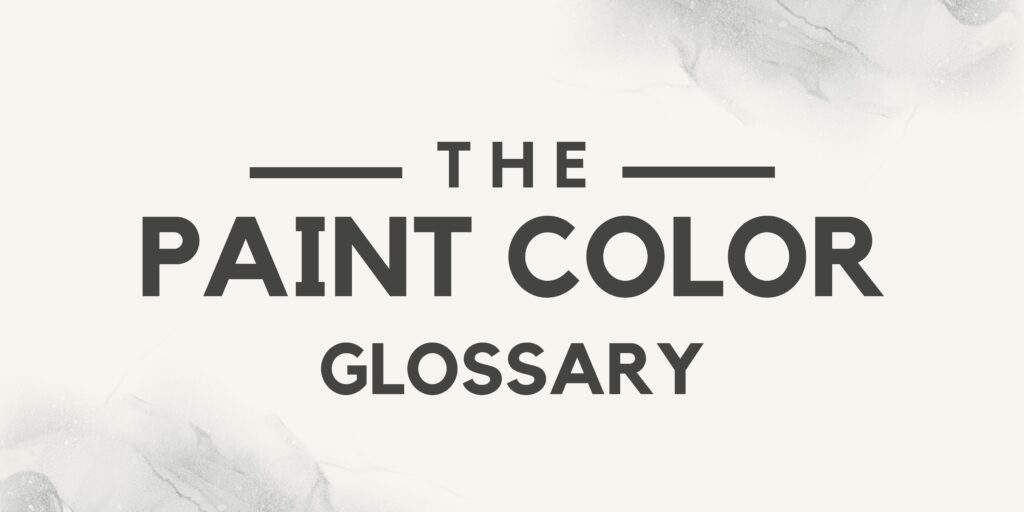Explore our comprehensive paint terminology glossary, where we demystify essential concepts like paint types, sheens, LRV, undertones, and color depth. Empower your home decor decisions with clear explanations, transforming your spaces one brushstroke at a time.
Welcome to the PaintColorProject Glossary, your ultimate guide to navigating the colorful world of interior and exterior home paint!
Whether you're a homeowner embarking on a painting project or a DIY enthusiast seeking the perfect hue, this glossary is designed with you in mind.
Our glossary is here to demystify the terminology, offering clear explanations of essential concepts related to paint types, sheens, Light Reflectance Value (LRV), undertones, and color depth.
Dive in to discover the nuances of each term, empowering yourself to make informed decisions about your home decor endeavors.
So, start exploring and gain the confidence to transform your living spaces with the perfect paint colors. Your dream home is just a brushstroke away. Happy painting!

Glossary of Paint Terminology
Here are some key terms to understand when reading about and choosing paints for your home!
Paint Types
Understanding paint types is the first step towards achieving a flawless finish. Explore our detailed guide to different paint formulations, empowering you to choose the perfect solution for your home decor needs.
Latex Paint
Latex paint, also known as water-based paint, is a popular choice for homeowners and DIYers. It dries quickly, has low levels of toxic fumes, and is easy to clean up with water. Latex paints come in various finishes and colors, making them versatile for interior and exterior applications.
Oil-Based Paint
Oil-based paint is made with oil as the solvent. It provides a durable finish, making it suitable for high-traffic areas. However, it has a strong odor, longer drying time, and requires mineral spirits for cleanup.
Chalk Paint
Chalk paint is a decorative paint known for its matte, chalky finish. It adheres well to various surfaces without extensive prep work, making it a favorite for furniture and decorative projects.
Sheens
Paint sheen refers to the level of gloss or shine present in a painted surface after it dries. Different sheen levels, such as matte, satin, and gloss, determine the visual appearance and durability of the paint.
The choice of sheen affects both the aesthetics and functionality of the painted area, making it a crucial consideration in interior and exterior painting projects.
Matte Finish
Matte paint has a non-reflective surface, making it ideal for hiding imperfections on walls. It provides a velvety appearance but may not withstand frequent cleaning, depending on the quality of paint.
Eggshell Finish
Eggshell finish has slightly more sheen than a matte finish, without being glossy at all. Take a look at an egg - the shell isn't chalky, but it isn't reflective whatsoever.
Eggshell is my pick for an interior wall's paint sheen 95% of the time.
Satin Finish
Satin paint has a subtle shine and is more washable than matte finishes. It is glossier than eggshell without being super glossy.
Personally, I do not like how the sheen of satin paint looks on walls. It draws attention to the texture and any flaws on the wall.
Gloss Finish
Gloss paint has a shiny surface that reflects light, creating a polished look. It's highly durable and easy to clean, making it perfect for trim, doors, and accents.
LRV (Light Reflectance Value)
Light Reflectance Value measures the percentage of light a paint color reflects. Higher LRV values indicate lighter colors, while lower values represent darker colors.
Understanding LRV helps homeowners choose colors that work well with their room's lighting conditions.
Color Temperature
Color temperature refers to the characteristic hue of a light source, measured in Kelvin (K). It describes whether a light source emits warm, neutral, or cool tones.
Lower color temperatures (around 2700K) appear warm and yellow, resembling the soft glow of candlelight, while higher temperatures (around 5000K and above) produce cooler, bluish tones akin to daylight.
Understanding color temperature aids in choosing paint colors that complement the warmth or coolness of the light in a room.
Undertones
Undertones in paint refer to subtle, underlying hues that are present within a specific color. Understanding these undertones is essential as they influence how the color interacts with surrounding light, furniture, and other elements in a space.
Identifying undertones helps homeowners and designers create harmonious color schemes and ensures the chosen paint complements the overall aesthetic of the room.
Warm Undertones
Colors with warm undertones have hints of red, yellow, or orange. They create a cozy and inviting atmosphere and pair well with earthy tones.
Cool Undertones
Colors with cool undertones have hints of blue, green, or purple. They evoke a calming effect and work well in spaces with ample natural light.
Neutral Undertones
Neutral colors have balanced undertones, making them versatile and suitable for various design styles. They can read as warm or cool depending on the specific lighting and surroundings.
Color Depth
Color depth refers to how light or dark a color appears. Light colors have a high color value and are often used to create a spacious feeling in small rooms. Dark colors have a low color value and add drama and coziness to larger spaces.
Value Scale
A value scale is a visual representation of the range of lightness and darkness within a set of colors. It consists of a series of colors, typically varying from white to black, with various shades of gray in between.
The value scale helps artists, designers, and decorators understand and control the contrast and balance between light and dark tones in their work.
When it comes to paint colors, value scale helps you consider contrast. For example, I prefer contrast from a front door to a home siding color. Thinking in terms of value scale can help you to choose shades with enough contrast to be visually interesting!
Color Harmonies
Color harmonies are predefined color schemes that involve specific relationships between colors on the color wheel. Understanding these harmonies is essential for creating visually pleasing and balanced designs.
Complementary Colors
Complementary colors are pairs of colors that are opposite each other on the color wheel (e.g., red and green, blue and orange, yellow and purple).
These combinations create strong contrasts, making each color stand out vividly when placed together. Complementary color schemes are impactful and dynamic.
Analogous Colors
Analogous colors are hues that are next to each other on the color wheel (e.g., blue, green, and teal). Analogous color schemes provide a sense of harmony and are often found in nature.
They offer a smooth transition between colors, creating a pleasing and comfortable atmosphere in a space.
Monochromatic Color Scheme
A monochromatic color scheme involves different shades, tints, and tones of a single color. By using variations in lightness and darkness within the same hue, monochromatic schemes offer a subtle, sophisticated look.
They create a sense of unity and elegance in a design, making them popular choices for interior decor.
Before you go...
Wow, that was a lot! Want picking paint colors to be easy? You need the Paint Color Formula!
Still unsure which paint color is right for your space?
Choosing paint doesn’t have to be stressful! My free Paint Color Planning Quick Start Guide walks you through the exact steps to confidently choose the perfect color — without the overwhelm, second-guessing, or endless swatch testing.
👉 Click here to download the free guide!

My Paint Color Formula course walks you through the painless process of expertly testing paint swatches to ensure you have the perfect color for your home.
The best way to sample paint? Samplize!
Get peel-and-stick removable and reusable paint samples here!
Thanks for reading!
